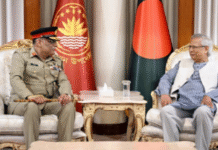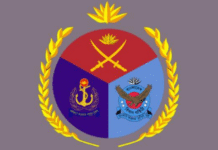Collapsed Rana Plaza security guard Habibur Rahman did not find his sons Md Solaiman and ‘Sentu’ trapped under the debris of the nine-storied building.
Solaiman and Sentu were working at Phantom Apparels as calendar operators on the fourth floor of the building at Savar, on the outskirts of Dhaka, when it trembled and collapsed on Apr 24 last year.
One of the world’s worst industrial disasters, the Rana Plaza collapse claimed over 1,100 lives, most of them workers of five readymade garment factories housed in the building.
Six months after the incident, Habibur learnt from DNA test results that Solaiman’s remains had been buried at the Jurain graveyard, but Sentu still remains untraced.
Habibur told bdnews24.com: “I’ve been to all places, including the offices of BGMEA and the district administration. But nobody could give any hint of my son’s whereabouts.
“Had I found the body of my son, my mind would have been at rest.”
He said he did not receive any financial help from the government after the death of his sons.
Another father, Motaleb Sheikh, could not find his elder daughter, who was trapped under the ruins.
Tears welled up in his eyes when asked about his daughter, Asma Begum.
He told bdnews24.com: “My daughter had just stepped onto 18. We were in dire financial straits. She told me, ‘Father, I’ll work at a garment factory’. I would not have lost her had there been no want in the family.

“I don’t know where my daughter is. I tried every means but could not find (her). I don’t know if she is alive or dead.”
The list of those still waiting for their dear ones trapped under the Rana Plaza is a long one.
According to some estimates, 100 more families are still looking for their missing members even a year after the accident.
The government or BGMEA (Bangladesh Garment Manufacturers and Exporters Association), have not been able to ascertain the actual number of those unaccounted for and prepare a list.
Relatives of the missing workers said they could not claim compensation in the absence of such authentication.
The list that the Labour and Employment Ministry gave to the High Court had put the number of missing people as 379, but the army, which led the rescue operation, had a lower figure, 261.
Later, identities of the remains of 157 were determined through DNA tests in the first phase and of 42 more in the second.
If the ministry list is taken to be correct, 180 more people are to be accounted for after identification of the remains of the 199.
A workers’ organisation, Garments Sanghati, however, said in a press conference in March that 143 labourers remained untraced.
Sanghati’s central committee member Deepak Roy told bdnews24.com: “We’re certain about the 143. But the number of the missing might be higher.”
He said though families of the dead and injured workers got some financial help, the relatives of those not on the missing labourers’ list have got nothing.
“So we want that the government to pronounce the missing as dead after a proper investigation.”
Asked about the missing, BGMEA President Md Atiqul Islam said a committee was formed comprising representatives of the association, labour ministry, and the Prime Minister’s Office on Apr 19. “They’ll prepare a list of the actual missing people,” he added.
Asked when the list might be published, Islam said: “We want to pay the dues of the families of the missing labourers. So, instruction has been given to have list ready as quickly as possible.”
A total of 2,438 people were rescued alive from under the ruins. Of them, 850 underwent treatment in hospitals.
Aroti Bala Das, who was working on the fourth floor with her mother Bina Bala Das, was rescued from the site three days after the incident, but her mother was not as fortunate.
“I won’t get back my mother. I miss her all the time.”
Aroti said her family had been economically hit by her mother’s death.
“I, my mother, and my father used to work in garment factories. I lost my leg and my mother in the incident. We used to live on the earnings of three people. Now we have to depend only on my father’s income.”
‘Roshnara’ was working in a garment factory on the second floor of Rana Plaza when it collapsed. She could manage to get out of the building after the accident but her nephew, ‘Saidur’, working in the same factory, was less fortunate.
Roshnara, who had brought up Saidur, did not get his body. Six months after the incident, she came to know from the DNA test that his nephew’s remains had been buried at the Jurain graveyard.
She said had got no financial help from the government.
The families of the Rana Plaza victims got Tk 221.35 million from prime minister’s fund as assistance. Of the amount, relatives of 798 dead got Tk 123.35 million and 35 critically injured Tk 39 million.
Besides, BGMEA offered Tk 145 million for the treatment of injured workers.
Asked if the money offered to the injured and the families of the dead was adequate, Labour Secretary Mikail Shipar told bdnews24.com: “The existing law provides for a compensation of Tk 0.1 million in case of death of a labourer at the workplace. It has been considered standard.”
He said the International Labour Organisation (ILO) started work to raise a $40-million fund for the workers and their families affected by the Rana Plaza incident. “Until now Tk 6 million has been collected,” he added.
The five factories in the Rana Plaza used to make garments for 27 international brands. However, no brand other than Wallmart, GAP, Children Palace and Primark has contributed to the fund.
Source: Bd news24









